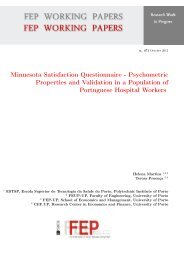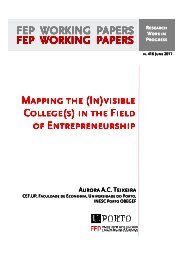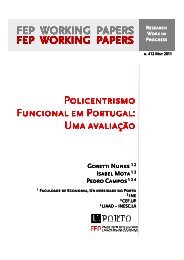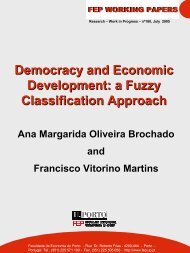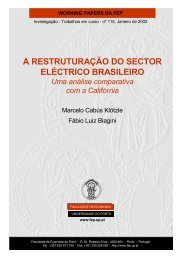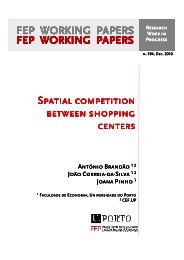Ant Colony Optimization: a literature survey - FEP - Working Papers
Ant Colony Optimization: a literature survey - FEP - Working Papers
Ant Colony Optimization: a literature survey - FEP - Working Papers
Create successful ePaper yourself
Turn your PDF publications into a flip-book with our unique Google optimized e-Paper software.
• allowing the construction of unfeasible solutions and then discarding or penalizing unfeasiblesolutions. In this case, it may happen that the number of usable solutions is toosmall (or even nonexistent), and thus the algorithm converges quickly to a suboptimal solution.Even if this is not the case, if there are several constraints being violated then it istoo hard to use the penalties since they are of different nature and thus may have oppositebehaviours;• if only feasible solutions are allowed, then the construction procedure may be too complexleading to large running times.The construction of a solution is influenced by many aspects, such as the problem being solvedand the constraints to be considered, the representation chosen for the problem, the investigatorpreferences, and so on.Alaya et al (2004) solve a Multidimensional Knapsack problem where a decision on a subsetof objects, satisfying a few resource constraints, has to be made in order to maximize the totalprofit. The solution for this problem only requires the choice of a subset of objects to be introducedin the knapsack, with no order specified, and can then be represented as a string of objectidentifiers. Each ant starts the construction of their solution by randomly choosing an objectto be put in the knapsack. Then, objects are added to the solution, by using a transition ruleas defined in equation (1), as long as they do not violate any resource constraint. This way afeasible solution is always obtained.Rappos and Hadjiconstantinou (2004), in order to design two-edge connected flow networks,use two types of ant colonies sharing information about their pheromone levels. This problemis about configuring a network in order to satisfy demand nodes, provided that an extra arc isconsidered to keep the network flowing in the case that one of the arcs in the network fails.The solution for this problem is constructed in two phases, each of which solved by a differenttype of ants. One ant colony is inhabitated by flow ants and the other colony by reliability ants.The number of flow ants is the same as the number of demand nodes and, although they allstart constructing their solution from the source node, each ant is assigned to reach just onespecific demand node. When all flow ants have constructed their partial solutions, reachingtheir demand node destination, the network is created. The next step involves the reliabilityants whose objective is to decide upon the extra arc, called reliability arc, to be added to thesolution. For every flow ant a reliability ant is created and associated with each arc visited bythe flow ant. Therefore, for each flow ant there is a set of reliability ants, as many as arcs inthe solution of the flow ant. The objective of a reliability ant is to find an alternative path fromthe root node to the same destination node of the flow ant as long as it does not use a particulararc, from the ones used in the solution of the flow ant. This ACO algorithm provides a singlefeasible solution at each iteration, which is only entirely defined when all partial solutions ofthe flow ants have been assembled together, and the extra arc found by the reliability ants is8



